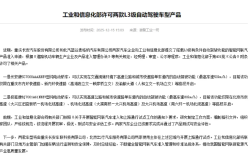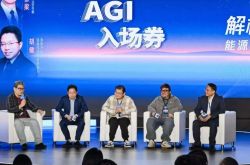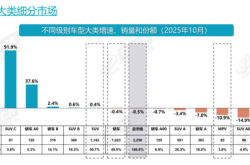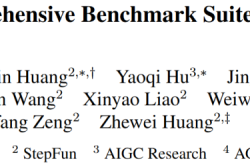DingTalk Embraces Simplicity: 'Less is More' in AI-Driven Transformation
![]() 08/26 2025
08/26 2025
![]() 495
495
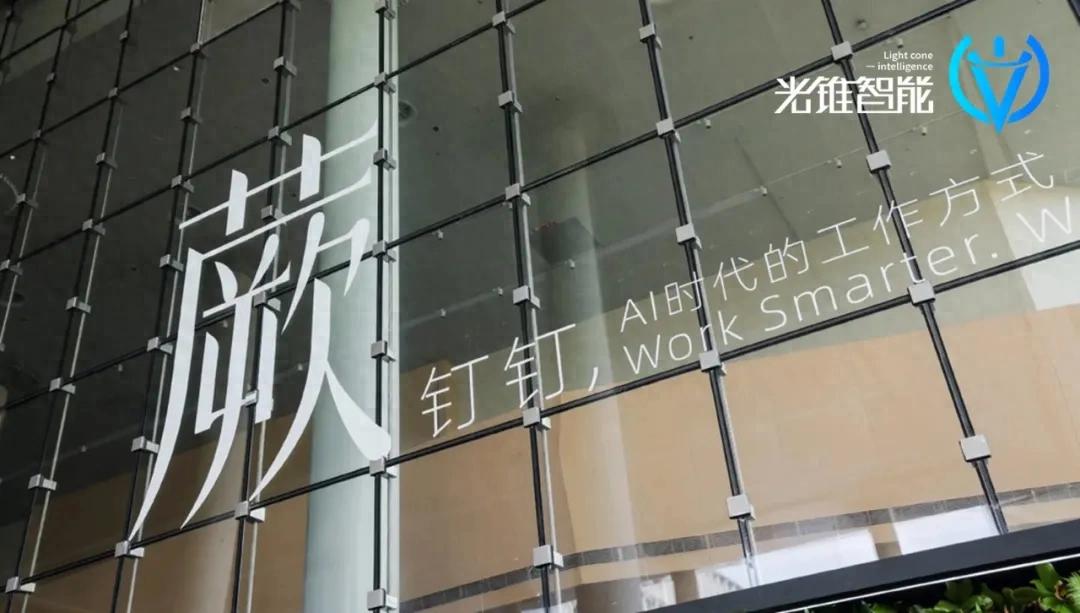
Four months after his return to DingTalk, founder Chen Hang (alias: Wuzhao) unveiled a thoroughly revamped DingTalk.
"When I first returned to DingTalk four months ago, I conducted a comprehensive user survey and received a lot of feedback," Wuzhao said at DingTalk's 10th-anniversary conference in 2025. "Over the past decade, many users have commented that DingTalk's design is outdated, and the page layout is cluttered."
Therefore, Wuzhao's first priority upon returning was to rebuild DingTalk from the ground up.
The new version of DingTalk is centered around simplicity, efficiency, and user-centric design. "In four months, we analyzed and designed 1,850 requirements, fixed 574 issues, and optimized over 20 product lines," Wuzhao revealed.
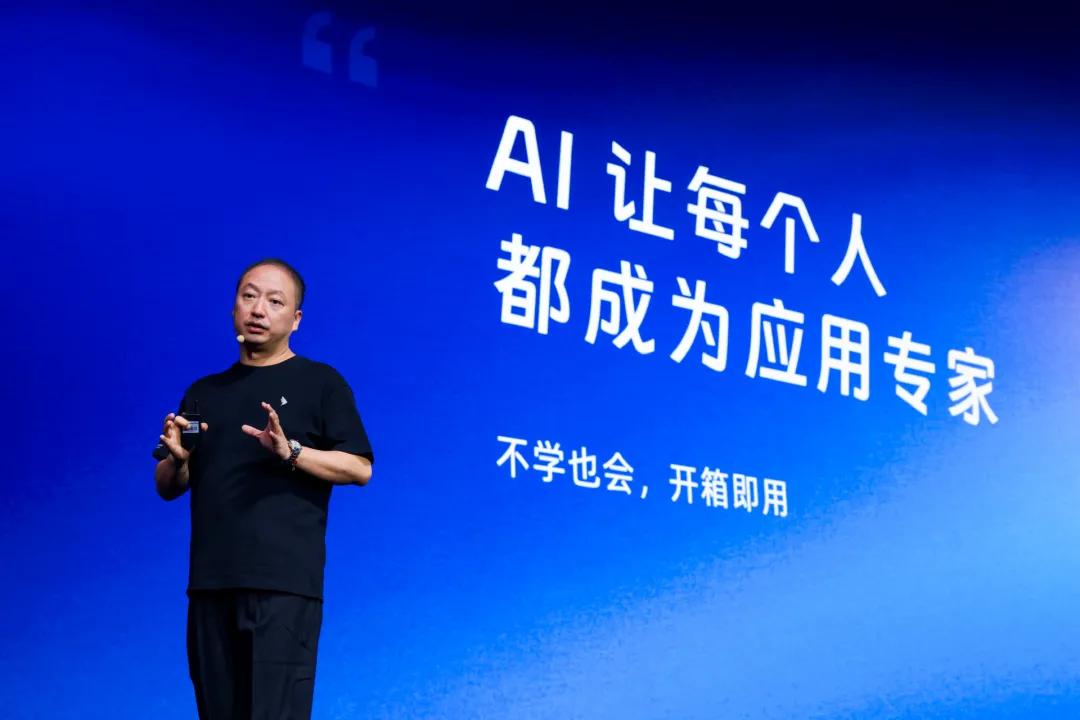
(DingTalk founder and CEO Chen Hang, alias Wuzhao)
On August 25, after a comprehensive overhaul, DingTalk 8.0—AI DingTalk 1.0—was officially launched. It features a new page layout design and introduces five AI products: DingTalk One, AI Search and Answer, AI Spreadsheet, AI Transcription, and smart hardware DingTalk A1.
DingTalk also announced its focus on three key sectors: customer service, marketing, and education. It will launch industry-specific AI large model products, establish a global enterprise-level AI assistant marketplace, and provide novel solutions tailored for overseas enterprises, SMEs, and large corporations.
DingTalk 1.0 was released in 2015, and ten years later, it has evolved to version 8.0. At this conference, Wuzhao emphasized how DingTalk is being rebuilt for the AI era, with AI DingTalk 1.0 offering a preliminary answer.
In fact, DingTalk had already deployed AI during the initial large model boom. Under Ye Jun's leadership, functional iterations were more aligned with the logic of AI ecosystem operations. Wuzhao's return has undoubtedly redirected DingTalk back to the 'product is king' philosophy.
However, amid fierce competition from industry rivals, AI DingTalk 1.0 appears to be just a beginner. All its updated AI products are still within the scope of its competitors. Whether it can eventually surpass them will depend on the real-world product experience.
This year marks another pivotal turning point in DingTalk's development journey.
At the start of 2025, DingTalk embarked on a transformation path from a collaboration tool to an AI intelligent platform. Will Wuzhao, who has returned to simplify DingTalk, enable it to win with less in the new decade?
Rebuilt AI DingTalk 1.0
Entering the AI era, the collaborative office landscape is being reshaped, with DingTalk, Feishu, and WeChat Work intensifying their AI focus. Over the past decade, DingTalk defined the workstyle in the cloud and mobile internet era. In the new decade, DingTalk aims to redefine the workstyle in the AI era.
DingTalk 8.0 is named 'Fern,' the earliest higher plant on Earth, symbolizing the true formation of a life system. Thus, DingTalk 8.0 signifies that DingTalk will take root in the industry, reconstruct its internal structure, and thrive externally. "DingTalk 8.0 is also AI DingTalk 1.0. We are determined to leave the past behind and create a brand-new DingTalk for the AI era with a mindset of returning to zero," Wuzhao said.
So, what sets the rebuilt AI DingTalk 1.0 apart?
The updates to AI DingTalk 1.0 are mainly reflected in two areas:
First, the overall page layout and function design of DingTalk have been optimized and refreshed.
Second, AI upgrades and iterations have been implemented in product functions.
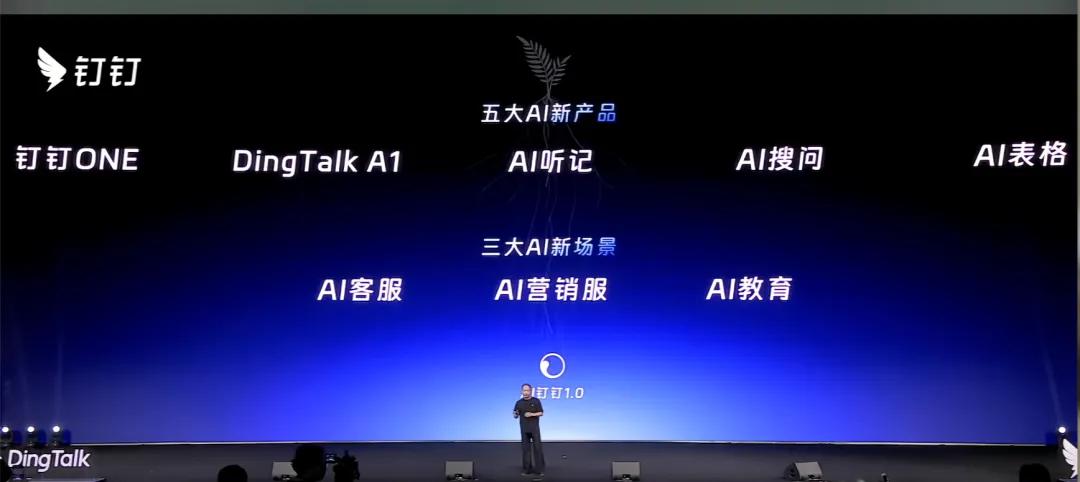
Simplicity is the first core of DingTalk 8.0's update, targeting the redundant pages and function designs that DingTalk has been criticized for. The 8.0 version has revamped the colors of titles, buttons, and dividers, making the page more concise and clear, in line with modern aesthetics. Functionally, all features have been streamlined, with redundant ones removed, allowing users to focus more on work.
Another core is efficiency, evident in the deep integration of AI into various work scenarios to provide intelligent recommendations for users.
For instance, when initially creating an enterprise, users can set up an enterprise work platform with a single AI command, intelligently matching the required applications and tools, letting the applications find people. At the top of DingTalk, there's a built-in AI efficiency island. AI analyzes all user workflows in real-time and automatically prioritizes tasks. It also reminds users in advance based on meeting times, enabling them to handle all work more calmly.
To further enhance workflow efficiency, various office software tools are indispensable. AI DingTalk 1.0 introduces five AI products: DingTalk One, AI Search and Answer, AI Spreadsheet, AI Transcription, and smart hardware DingTalk A1.
DingTalk One is the first Agent-driven work information flow created by DingTalk for the AI era. In essence, it creates a dedicated AI work secretary and AI learning secretary for users.
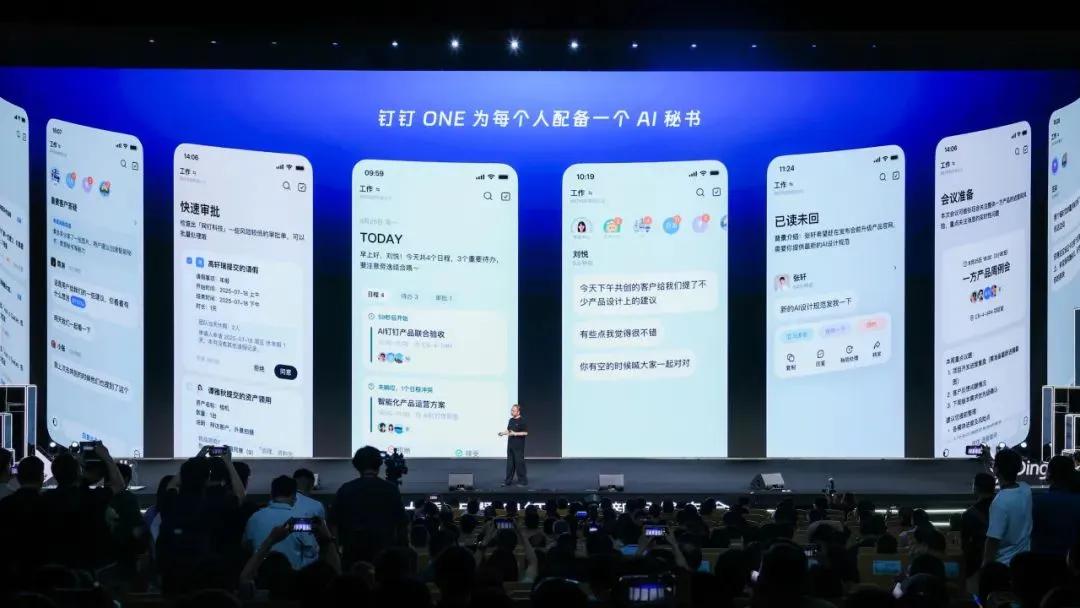
The AI work secretary organizes all work-related information and tasks by priority, clearly presenting them to users in the form of information flow cards, shifting from 'people finding things' to 'things finding people'.
The AI learning secretary replaces the past practice of sharing enterprise information mainly through group chats. Enterprises can use AI to gather and translate new products, technologies, trends, and viewpoints related to the industry, pushing them to employees like internal video numbers or Douyin.
In summary, DingTalk One acts like a personal butler for users, assisting them with various tasks.
Another significant product capability in the AI iteration of collaborative office software is AI knowledge Q&A. DingTalk AI Search and Answer integrates AI search and AI knowledge Q&A to provide one-box search and answer solutions, offering a way for enterprise employees to acquire knowledge in the AI era.
Based on text search engines, knowledge graph search engines, and other capabilities, DingTalk AI Search and Answer can accurately provide answers within the user's permission scope, whether searching for people, events, knowledge, or inquiring about work progress.
Additionally, AI Search and Answer has launched the model fusion engine AI Fusion, which brings together over 50 mainstream large models worldwide. Enterprises can check the models in AI Fusion to compare question-and-answer effects and thereby choose the most suitable model.
AI spreadsheets have become a hotly contested area for collaborative office software. This July, DingTalk also introduced the AI Spreadsheet function.
At this conference, DingTalk AI Spreadsheet was upgraded, enabling functions such as unified domain data, automated business process operation, and at-a-glance business overview. It also launched multiple AI capabilities, including AI Spreadsheet Assistant and Field Agent.
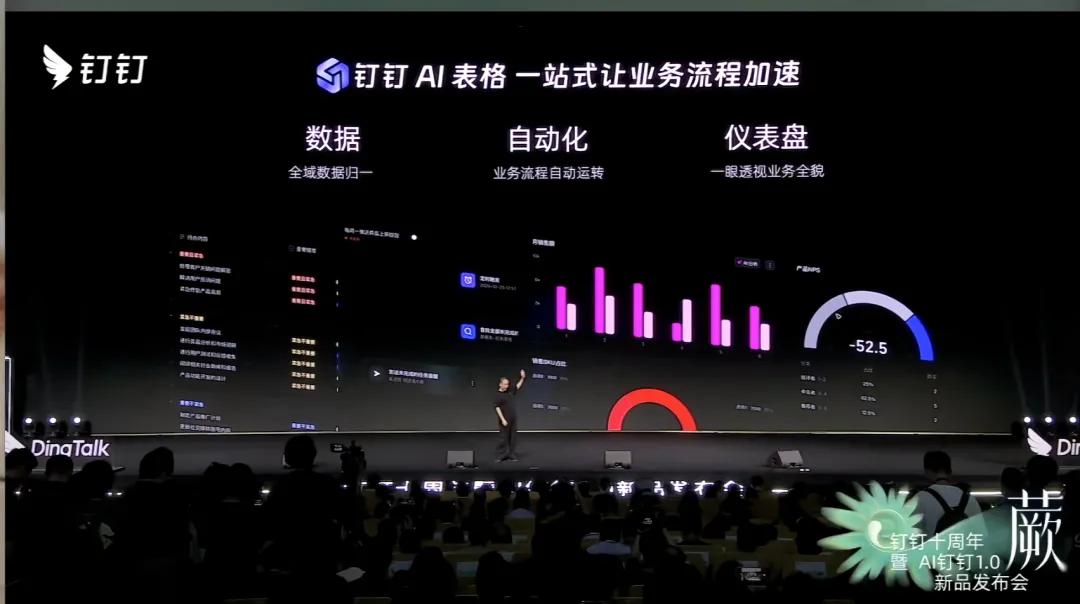
With the help of AI Spreadsheet Assistant, users can generate AI spreadsheets, automated workflows, and dashboards simply by describing their ideas in a conversation. They can also perform basic operations like asking for numbers, formula statistics, or sorting, coloring, and widening tables.
It is reported that currently, over 300,000 enterprises on DingTalk have created business applications using AI Spreadsheets.
Worth mentioning is that DingTalk 8.0 also launched a new generation of voice intelligence tool 'AI Transcription' (AI Minutes) and its first smart hardware product, DingTalk A1.
DingTalk A1 deeply integrates AI transcription capabilities at the software level and seamlessly connects with DingTalk's to-do list, calendar, and other applications. It can activate over 10 types of DingTalk AI assistants and support user customization.
Through this product update, it's evident that DingTalk is accelerating its pursuit of Feishu in terms of AI product functions.
On one hand, the updates to AI product functions are more about addressing the original shortcomings and deeply integrating AI into the entire DingTalk workflow. However, whether it can eventually stand out will depend on the real user experience.
On the other hand, DingTalk is currently the first collaborative office software in China to release hardware products. Whether it can form a differentiated competitive advantage among traditional hardware vendors such as iFLYTEK in dictaphones and translation machines remains to be seen.
Nonetheless, Wuzhao's return has enabled DingTalk to address its AI shortcomings in a short period. After addressing product shortcomings, the next step is to take root in the industry and thrive the entire AI ecosystem.
Focusing on Three Major Industries: Customer Service, Marketing, and Education
Transitioning from tools to industries is the path DingTalk has taken to deepen its business over the past few years. Initially, DingTalk aimed to achieve this through the 'integration of cloud and DingTalk,' but it didn't pan out.
After Wuzhao's return, there are clearly new strategies in place.
Previously, it was reported that DingTalk recently established a new business line, the industry-specific model team, reporting to DingTalk CTO Zhu Hong.
At this conference, Wuzhao officially announced that AI DingTalk 1.0 will focus on three major scenarios: customer service, marketing, and education. It will create AI customer service large models, AI marketing services, AI education products, and use AI to reconstruct the workflows of these three scenarios.
First, the customer service scenario. Why does DingTalk want to rebuild the customer service scenario?
"This started when I returned to DingTalk. Initially, the BD team reported a high renewal rate and customer satisfaction. The head of online customer service also said all problems had been resolved, with a low transfer rate to humans at only 15%," Wuzhao said. "But during subsequent nationwide surveys, customers told me their demands had gone unanswered for over a year. Online customer service often gave irrelevant answers, and they couldn't find the interface to transfer to humans."
In fact, this isn't just a DingTalk issue; many software products' AI customer service faces similar problems. Based on this, after Wuzhao's return, he decided that the first scenario to be rebuilt with AI would be AI customer service.
To ensure the effectiveness of the AI customer service large model in the industry, Wuzhao reorganized the data engineering team, model training team, and effect evaluation team upon his return. The three teams jointly completed the training of the AI customer service large model, ensuring data authenticity and accuracy. This allows AI to understand Q&A, knowledge, and user manuals while ensuring the final AI results don't give irrelevant answers or generate fantasies.
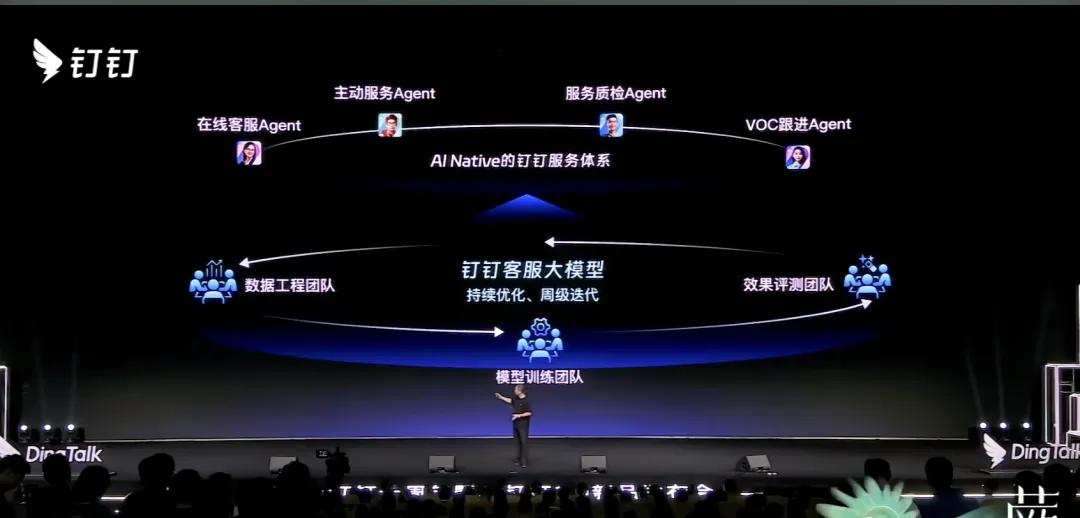
Simultaneously, DingTalk rebuilt the customer service Agent service in an AI-native manner, establishing four digital human assistants: online customer service Agent, proactive service Agent, service quality inspection Agent, and VOC follow-up Agent, to achieve automated customer service.
Based on the newly developed AI customer service, DingTalk can support the entire VOC omnichannel demand of customers, automatically following up after identifying all demands. When the demand involves research and development, it can also automatically connect with the production and research system.
"Everything has a response, and everything has a conclusion," Wuzhao said. "Our customer service satisfaction rate has increased from 30% to 80%, and we've reduced costs by 90% at the same time."
In the marketing scenario, the problem often lies in the lack of transparency in the entire sales process and the lack of management of the intermediate sales process, often leading to poor final sales results. DingTalk's solution is to manage the entire sales process transparently through hardware.
Based on DingTalk A1, DingTalk will create three hardware products—DingTalk A1 Lite, DingTalk B1, and DingTalk B2—for the marketing scenario. These use intelligent voice to realize AI sales assistant, AI service quality inspection, AI intelligent insight, and other capabilities in the sales process and summary analysis.
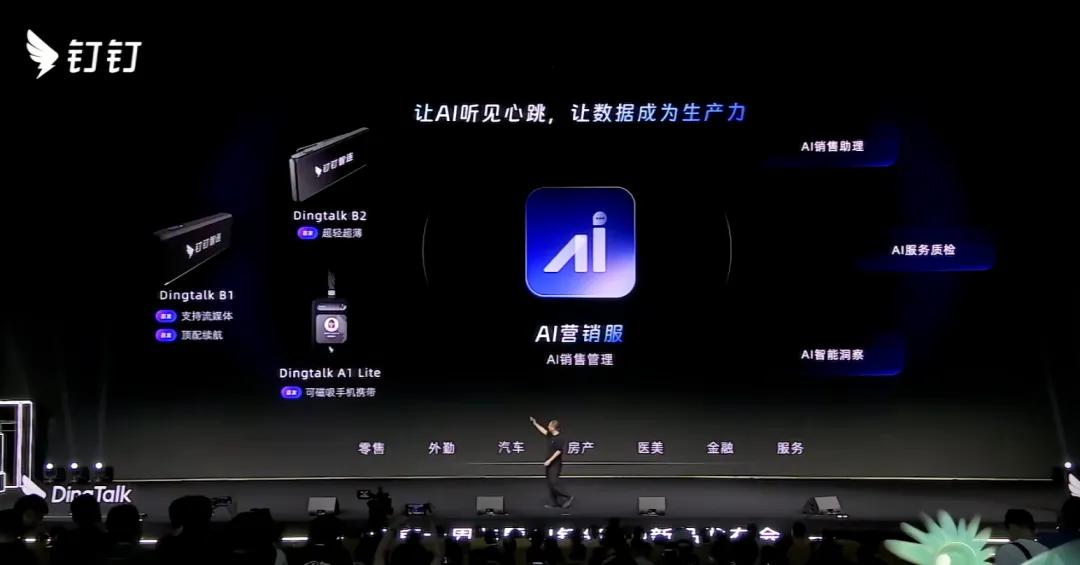
For the education scenario, DingTalk has partnered with Quark to achieve full-scale AI homework correction, covering all school stages and subjects, including mathematics, Chinese, English, and even physical education like rope skipping and sit-ups, which can all be automatically analyzed and corrected.
"With AI homework correction, teachers can save their daily homework correction time from 2 hours to 10 minutes," Wuzhao said. For the collation of wrong questions, DingTalk can also automatically establish class and student personal wrong question books, achieving fully automated classification and summary of wrong questions.
Focusing on these three scenarios is DingTalk's choice based on its current development status and Alibaba's AI innovation business development system. This aligns with Wuzhao's concept of simplifying DingTalk. Only by taking root in a few scenarios can it expand outward effectively.
Additionally, the AI DingTalk 1.0 version introduces a new product for large and medium-sized enterprises, 'Your DingTalk,' offering exclusive brands, storage, deployment, and AI solutions tailored to their needs.
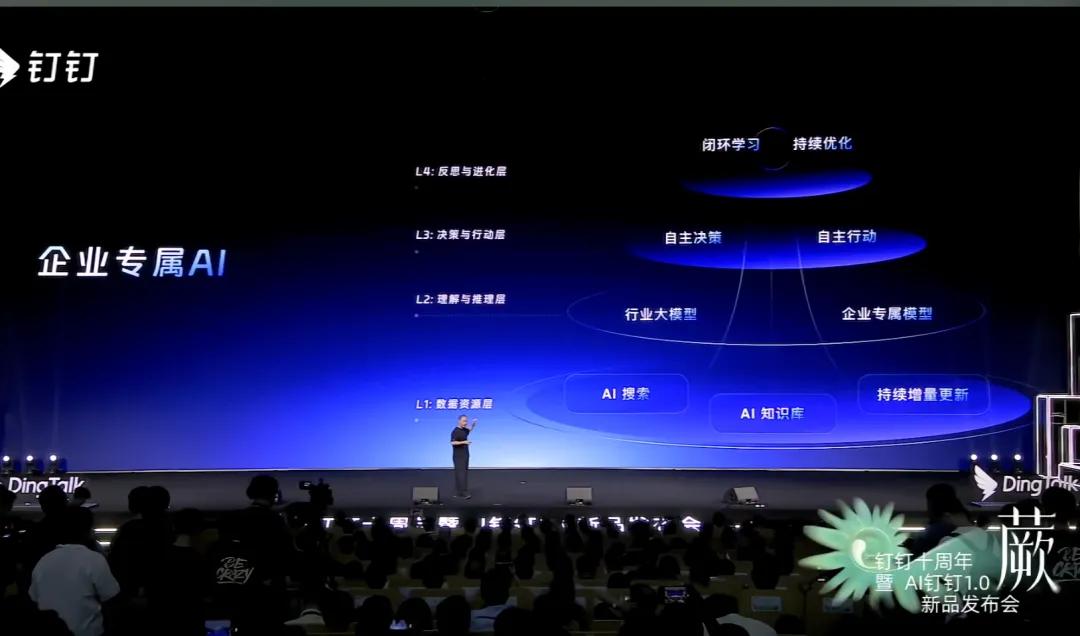
At the enterprise-exclusive AI level, DingTalk offers a tiered approach to AI product design, encompassing four distinct levels:
Level L1: Basic Digital Resource Management, including AI search, AI knowledge base, and a system for incremental knowledge updates.
Level L2: Understanding and Reasoning, encompassing data refinement and enhancement services, AI customer service capabilities, and deep customization and consulting services tailored to enterprises.
Level L3: Autonomous Decision-Making and Action. Taking CITIC Metal's metallurgical business as an example, DingTalk facilitates AI adaptive learning, autonomous decision-making, code invocation, and execution, enhancing product quality.
Level L4: Reflection and Evolution, a closed-loop learning layer. Wuzhao acknowledged, "L4 is our aspirational direction, yet to be achieved and requiring collective efforts."
Furthermore, DingTalk has undergone a comprehensive upgrade of its application service market. The new market is segmented into Selected Application Market, AI Hardware Market, AI Template Market, AI Assistant Market, and Customer Reviews, with each section experiencing updates and enhancements.
Currently, the DingTalk application market boasts over 6,000 partners, generating over 3 billion in revenue annually, with 50 partners exceeding 10 million in earnings.
Since Wuzhao's return, he has not only streamlined products but also rooted DingTalk deeper into the industry, focusing on three core scenarios to serve a myriad of industries effectively.
In serving enterprises, DingTalk has categorized the hierarchical capabilities of AI, providing a clear division of services to meet the diverse needs of businesses while paving the way for subsequent paid enterprise services.
Wuzhao's Return to Entrepreneurship and DingTalk's Quest for an Ace Product
Wuzhao is a serial entrepreneur. A decade ago, following the unsuccessful launch of Laiwang, he reestablished DingTalk. At that time, as a second-generation entrepreneur, his focus was solely on creating exceptional products.
Four years ago, Wuzhao left Alibaba to venture independently. "That's when I truly understood entrepreneurship, starting from scratch," he recalled. "I even had to ration the use of elevators and control the air conditioning strictly."
With Wuzhao's return, DingTalk reverts to an entrepreneurial mindset. "DingTalk will rededicate itself to entrepreneurship, innovation, and user-centricity," he affirmed.
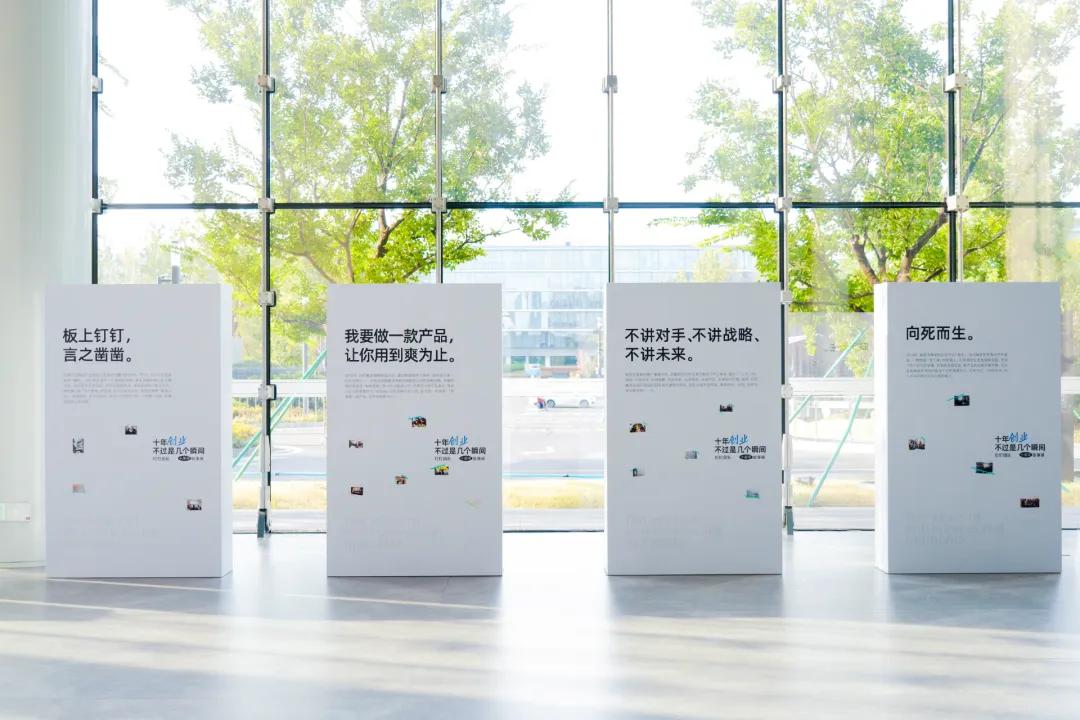
During DingTalk's nascent entrepreneurial phase, "co-creation" was Wuzhao's strategy for product positioning and improvement. In 2014, he led his team to visit hundreds of enterprises, introducing the concept of "co-creation partners." His team worked, met, and dined with client companies, refining products on-the-go based on customer needs.
Since his return, Wuzhao has once again engaged in co-creation with over 100 entrepreneurs from diverse industries. His immediate "undercover investigations" of customers spurred significant internal changes at DingTalk.
Based on co-creation and field visits, Wuzhao initiated a comprehensive overhaul at DingTalk, encompassing product design, troubleshooting, and rectification, with his active involvement at the forefront.
Concurrently, he strengthened internal management, adjusted the attendance system, and emphasized a return to an entrepreneurial spirit.
This internal overhaul at DingTalk can be described as radical, even drawing criticism on social media for its entrepreneurial style. However, the results have been promising, particularly in terms of product updates and iterations, addressing identified shortcomings.
Under Ye Jun's leadership, DingTalk had already laid the groundwork for large AI models. Wuzhao's return has accelerated this AI transformation, introducing numerous AI product capabilities and opening platforms to foster vertical industry model development.
Regarding the AI ecosystem, in March 2025, DingTalk launched the "AI Innovation N-th Power Plan" to expedite AI ecosystem construction with attractive support policies. This plan offers "three exemptions and four supports," waiving developer commissions, deposits, and computing fees while providing comprehensive assistance in brand promotion, sales channels, technical support, and investment matching.
With the advancement of AI technology, the enterprise service market is undergoing a profound transformation. DingTalk recognizes that deep integration of AI technology into products is crucial to maintaining a competitive edge. Additionally, Alibaba Group's strategic shift presents an opportunity for DingTalk's AI transformation.
Wuzhao and Alibaba's senior management have agreed on DingTalk's future AI transformation. Within Alibaba's AI innovation business, DingTalk is now positioned as the entry-level product for AI To B, complementing Lark (the flagship AI To C application).
According to Alibaba Group CEO Wu Yongming, DingTalk must evolve from a collaboration platform to a genuine AI smart hub. In the future, internal enterprise systems will form a dynamic network interconnected and invoked by multiple AI agents.
This elevated positioning will undoubtedly provide DingTalk with enhanced resources and support. However, addressing DingTalk's historical issues remains challenging.
As an industry pioneer, DingTalk innovated numerous applications early on. However, the Cloud-Ding integration strategy since 2020 tied DingTalk to the Alibaba Cloud system, stagnating its overall business development.
DingTalk initially commercialized through a PaaS-based approach, known as the PLG (Product-driven and PaaS-driven base) + SLG (Sales-driven and Service-driven) model. Until last November, Ye Jun still highlighted DingTalk's PLG + SLG commercialization path at the 2024 Autumn Summit.
Nevertheless, this path has proven unsuccessful. After a decade, as the AI era approaches, DingTalk not only lacks a standout AI product but also faces criticism for redundant page and function design.
In contrast, Lark, the industry's second-place contender, has recently launched several popular products. From documents to Lark Note to AI Sheets, each product precisely meets user needs.
Objectively, DingTalk trails Lark in the user experience of these tool-based products. Moreover, Lark poses a significant threat to DingTalk's industry leadership in market development.
DingTalk announced an ARR (Annual Recurring Revenue) of $200 million for the first half of FY 2025 (April to September 2024), aiming for breakeven in 2025. However, Alibaba's recent financial reports (October 2024 to March 2025) did not mention DingTalk's profitability.
At Lark's all-hands meeting around the 2024 Chinese New Year, CEO Xie Xin revealed that Lark's software subscription revenue surpassed $200 million in 2023, doubling year-on-year. Notably, these revenues stem solely from external customers, excluding ByteDance's internal usage and deployment/customization fees.
Regarding user data, according to QuestMobile, DingTalk leads with approximately 200 million monthly active users, followed by WeChat Work with 100 million, and Lark with 30 million.
While DingTalk remains the industry leader, it faces omnipresent challenges from upstarts.
"Lark's multi-dimensional tables are at least 12 months ahead of DingTalk," Xie Xin bluntly stated in a media interview this July, a rare admission of superiority by a competitor.
He sarcastically commented on DingTalk's AI capabilities: "If your office tool is primarily for clocking in rather than creation, a year's worth of data might just be 10 million clock-in records. Then, AI can perhaps predict which employees will be late tomorrow."
Xie Xin's remark underscores the fierce competition in the collaborative office market.
In summary, DingTalk's early innovation was key to its pioneering role. Now, amidst threats from new entrants, Wuzhao Chen Hang has returned with a mission to "deeply implement AI." In the AI era, returning to product logic and creating truly useful AI products will be the cornerstone of Wuzhao's reinvigoration of DingTalk, potentially achieving "victory without a move."


